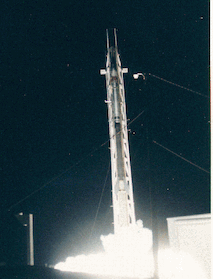X-ray Quantum Calorimeter (XQC) The X-ray Quantum Calorimeter rocket sounding
experiment (XQC) was a calorimeter flown on a series of
rocket flights to provide high resolution spectra of soft X-ray diffuse
background measurements and to test the instrumentation to be flown on
future X-ray missions. The instrument was flown six times
between December 1995 and March 2013, as shown in the table below.
The flights reached an altitude of 220 km
and provided few minutes of observation time per flight.
The X-ray Quantum Calorimeter rocket sounding
experiment (XQC) was a calorimeter flown on a series of
rocket flights to provide high resolution spectra of soft X-ray diffuse
background measurements and to test the instrumentation to be flown on
future X-ray missions. The instrument was flown six times
between December 1995 and March 2013, as shown in the table below.
The flights reached an altitude of 220 km
and provided few minutes of observation time per flight.
All of these rocket flights were launched from White Sands Missile Test Range, and the rocket and instrumentation were mated together by NASA’s Wallops Flight Facility. The two stage rocket would loft the instrument above the Earth’s atmosphere in a sub-orbital arc at night (using the Earth as a shield from solar X-ray background contributions). The entire flight would last just 15 minutes, of which roughly 2 minutes were observation time above 160 km altitude. Once above the atmosphere, the instrument would collect data, pirouette to scan across the Earth, then return to the observational target. The Earth scan provided a background noise measurement: X-ray instruments on some rocket flights have noted high particle background rates from precipitating electrons. The flight would then return to Earth, usually landing about 80 miles uprange from the launch site, parachuting down to a “soft landing”. The instrument could be recovered from the upper rocket component, usually at first light the next day. The instrument would be refitted, if necessary, for the next flight. The instrument consists of a 36-pixel array of microcalorimeters with two configurations. The early configuration was a 2 x 18 pixel array, flown in the first three flights (1995-1999), while the second configuration was a 6 x 6 pixel array flown in the last three flights (2008-2011). The pixel size in the early configuration was 0.5 x 2.0 mm with a collecting area of 0.36 cm2 and 2.0 x 2.0 mm in the second configuration with a collecting area of 1.44 cm2. The array was epoxied to a mercury-telluride (HgTe) x-ray absorber and kept at a temperature of 50 mk (60 mK for the early flights), which was achieved by an adiabatic demagnetization refrigerator. A strong magnet would align the spins of the paramagnetic HgTe, dumping the heat into a dewar containing supercooled liquid helium. Once chilled, the magnetic field would be slowly ramped down to maintain a constant temperature. An incident X-ray photon would strike the HgTe and liberate a photoelectron, which would in turn collide with other atoms, slightly heating the detector. By very precisely measuring the amount of heat deposited, a precise measure of the incident X-ray’s energy is obtained before the detector returns to thermal equilbrium, ready to detect the next X-ray photon. The energy resolution was a few eV in the energy range of 0.1-1.1 keV, with a resolution of about 6eV in the later flights compared to the 9eV in the earlier flights. Page authors: Lorella Angelini Jesse Allen HEASARC Home | Observatories | Archive | Calibration | Software | Tools | Students/Teachers/Public Last modified: Wednesday, 17-Jun-2020 17:21:40 EDT |

